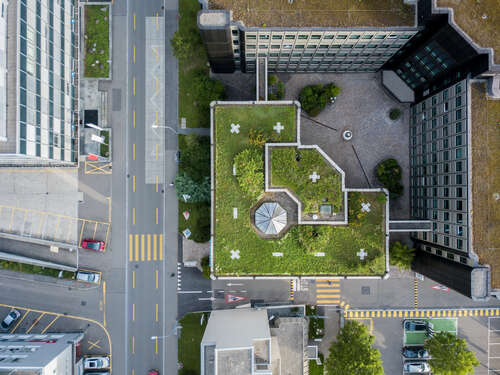
Cities around the world are reaching a critical juncture, with climate change driving temperatures to dangerous highs. This is only getting worse – the number of cities facing extreme temperatures of 35°C and above is expected to triple by 2050.

The built environment is a huge contributor to this build-up of heat in cities. That’s because we’ve inadvertently designed our cities to be even hotter. We’ve pushed out nature, concreted our streets and built high in steel and glass. This creates what is known as the urban heat island (UHI) effect – where urban temperatures are far higher than their rural surroundings.
It’s vital that city leaders, urban planners and designers consider how city design can affect urban heat.
It’s encouraging to see growing efforts to highlight the problem, with cities such as Athens appointing a chief heat officer to drive forward heat resilience planning and awareness. But there is plenty more to be done.
Our Urban Heat Snapshot maps extreme UHI “hot spots” in six major cities – Cairo, London, Los Angeles, Madrid, Mumbai and New York. It shows the urgent need for cities to tackle urban heat.
But it also shows that tackling this issue is not straightforward. Within cities, areas just a short distance from one another could experience vastly different temperatures, with some areas experiencing temperatures up to 8°C higher than others nearby. It also shows that the UHI effect does not impact everyone the same, with age and income factors that impact people’s ability to cool themselves.
So, where do we go from here?
The good news is that not only can urban heat be mitigated, but this can be achieved with solutions that have been around for centuries – combined with new technologies that can pinpoint the most impactful applications.
Plant more trees
Prioritising and investing in trees on our streets and neighbourhoods to increase the tree canopy cover in our cities is a must to reduce urban heat.
Trees in particular have been proved to lower temperatures in cities, and advanced technologies now allow designers to understand exactly the type and number of trees needed to impact urban temperatures. In Albania, Arup used its land mapping AI and machine learning tool, Terrain, to help design an Orbital Forest for Tirana – two million trees that aim to help the city address its heat and flooding challenges.
Increase permeable surfaces
Permeable surfaces, such as bare or planted soil, tend to absorb less heat compared with impermeable surfaces like concrete or asphalt. Sustainable urban drainage schemes are not only slowing down water runoff during heavy rainfalls, but also increasing areas of green space, and cooling neighbourhoods during hot temperatures.
By utilising nature, and collaborating with it, we can create sustainable and resilient cities that benefit both citizens and the environment.
Leverage data
Digital tools can help planners understand the impact of design choices on heat and adjust them accordingly. Arup’s UHeat tool allows rapid complex modelling, combining remote sensing data with a climate model, to provide the air temperatures of cities.
These tools expose the factors contributing to the urban heat island effect, giving city planners, designers, authorities, and those shaping cities the tools they need to rapidly understand the impacts of their design on urban heat, pinpoint specific interventions that can be developed at pace across an entire city to cool it down.
Use every space possible
More than half of the space in cities (including roofs and streets) is open space, providing a large canvas for building resilience – all that’s required is some creativity. Released alongside the Greater London Authority’s Climate Resilience Review, Arup produced the Roofs Designed to Cool report, assessing the benefits of mass roof retrofit, as part of the Mayor’s Climate Resilience Review.
Using reflective and solar PV can help cool buildings themselves, reducing the air conditioning as well as capturing energy to help decarbonise its energy use. This will have a significant impact on the urban heat island effect, by reducing the heat released by buildings at night.
Target cool spaces
With cities set for heatwave conditions every summer, we need to create a network of cooling spaces in cities for people to take refuge. Interventions as simple as bringing back drinking water fountains to cities could significantly improve citizen health.
When combined with information like cities’ socioeconomic make-up and heat vulnerability data, this can help target interventions where they are most needed.
Encourage behaviour changes
To create lasting resilience, people will need to change the way they live in cities within the next decade. Hot countries around the world have been adjusting their lives to this for centuries, and it’s time to learn from them – reconsider office hours, and introduce shop and restaurant closures over peak heat.
Adapting to extreme heat requires a vision and incremental implementation. But we cannot afford to shy away from this challenge – now is the time to rethink how we build and live in cities.
[Read more: Cities across the globe need to cool down in the face of extreme heat – here’s how]






